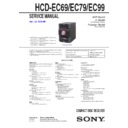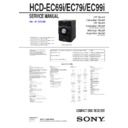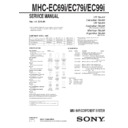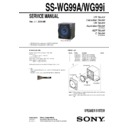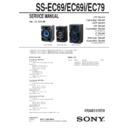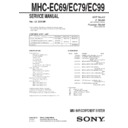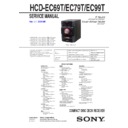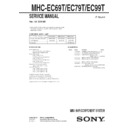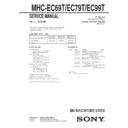Sony HCD-EC69 / HCD-EC79 / HCD-EC99 / MHC-EC69 / MHC-EC79 / MHC-EC99 Service Manual ▷ View online
SERVICE MANUAL
Sony Corporation
Audio&Video Business Group
Published by Sony Techno Create Corporation
HCD-EC69/EC79/EC99
SPECIFICATIONS
COMPACT DISC RECEIVER
9-889-442-03
2009I05-1
©
2009.09
AEP Model
E Model
HCD-EC69/EC79/EC99
Russian Model
HCD-EC69/EC99
Ver. 1.2 2009.09
• HCD-EC69 is the amplifi er, USB, CD player and
tuner section in MHC-EC69.
• HCD-EC79 is the amplifi er, USB, CD player and
tuner section in MHC-EC79.
• HCD-EC99 is the amplifi er, USB, CD player and
tuner section in MHC-EC99.
Photo: HCD-EC99
• “WALKMAN” and “WALKMAN” logo are registered trademarks of Sony Corporation.
• MICROVAULT is a trademark of Sony Corporation.
• MPEG Layer-3 audio coding technology and patents licensed from Fraunhofer IIS and
Thomson.
• Windows Media is a registered trademark of Microsoft Corporation in the United States
and/or other countries.
The following measured at AC 230 V, 50/60 Hz (European and
Russian models)
The following measured at AC 120, 127, 220, 240 V, 50/60 Hz
(Other models)
Russian models)
The following measured at AC 120, 127, 220, 240 V, 50/60 Hz
(Other models)
HCD-EC99
Front Speaker:
Power output (rated):
Power output (rated):
Low channel
50 W + 50 W (at 8 Ω, 1 kHz, 1% THD)
High channel
50 W + 50 W (at 8 Ω, 8 kHz, 1% THD)
50 W + 50 W (at 8 Ω, 1 kHz, 1% THD)
High channel
50 W + 50 W (at 8 Ω, 8 kHz, 1% THD)
RMS output power (reference):
Low channel
65 W + 65 W (per channel at 8 Ω, 1 kHz, 10% THD)
High channel
65 W + 65 W (per channel at 8 Ω, 8 kHz, 10% THD)
65 W + 65 W (per channel at 8 Ω, 1 kHz, 10% THD)
High channel
65 W + 65 W (per channel at 8 Ω, 8 kHz, 10% THD)
Subwoofer:
RMS output power (reference):
RMS output power (reference):
90 W (at 4 Ω, 80 Hz, 10% THD)
HCD-EC79
Power output (rated):
Low channel
55 W + 55 W (at 8 Ω, 1 kHz, 1% THD)
High channel
55 W + 55 W (at 8 Ω, 8 kHz, 1% THD)
55 W + 55 W (at 8 Ω, 1 kHz, 1% THD)
High channel
55 W + 55 W (at 8 Ω, 8 kHz, 1% THD)
RMS output power (reference):
Low channel
75 W + 75 W (per channel at 8 Ω, 1 kHz, 10% THD)
High channel
75 W + 75 W (per channel at 8 Ω, 8 kHz, 10% THD)
75 W + 75 W (per channel at 8 Ω, 1 kHz, 10% THD)
High channel
75 W + 75 W (per channel at 8 Ω, 8 kHz, 10% THD)
HCD-EC69
Power output (rated):
50 W + 50 W (at 6 Ω, 1 kHz, 1% THD)
RMS output power (reference):
70 W + 70 W (per channel at 6 Ω, 1 kHz, 10% THD)
Inputs
PC IN (stereo mini jack):
Sensitivity 800 mV, impedance 22 kilohms
Outputs
PHONES (stereo mini jack):
accepts headphones with an impedance of
8 Ω or more
8 Ω or more
SPEAKER: impedance
HCD-EC79/EC99: 8 Ω
HCD-EC69: 6 Ω
HCD-EC69: 6 Ω
SUBWOOFER (HCD-EC99 only): impedance 4 Ω
USB section
Supported bit rate:
MP3 (MPEG 1 Audio Layer-3)/WMA/AAC: 32
− 320 kbps,
VBR
Sampling frequencies:
MP3 (MPEG 1 Audio Layer-3)/WMA/AAC: 32/44.1/48 kHz
(USB) port:
Maximum current: 500 mA
CD player section
System:
Compact disc and digital audio system
Laser Diode Properties
Emission Duration: Continuous
Laser Output*: Less than 44.6μW
*
Laser Output*: Less than 44.6μW
*
measurement at a distance of 200mm from
the objective lens surface on the Optical
Pick-up Block with 7mm aperture.
the objective lens surface on the Optical
Pick-up Block with 7mm aperture.
Frequency response: 20 Hz
− 20 kHz
Signal-to-noise ratio: More than 90 dB
Dynamic range: More than 88 dB
Dynamic range: More than 88 dB
This output is the value
Tuner section
FM stereo, FM/AM superheterodyne tuner Antenna:
FM lead antenna
AM loop antenna
AM loop antenna
FM tuner section:
Tuning range:
87.5
− 108.0 MHz (50 kHz step)
Intermediate frequency: 10.7 MHz
AM tuner section:
Tuning range
European and Russian models:
European and Russian models:
531
− 1,602 kHz (with 9 kHz tuning interval)
Latin American models:
530
− 1,710 kHz (with 10 kHz tuning interval)
531
− 1,710 kHz (with 9 kHz tuning interval)
Other models:
531
− 1,602 kHz (with 9 kHz tuning interval)
530
− 1,610 kHz (with 10 kHz tuning interval)
Intermediate frequency: 450 kHz
General
Power requirements
European and Russian models:
Mexican model:
Argentine model:
Other models:
AC 120, 220, 230
AC 120, 220, 230
− 240 V, 50/60 Hz, adjustable with voltage
selector
Power consumption
HCD-EC99: 175 W (0.5 W at the Power Saving Mode)
HCD-EC79: 170 W (0.5 W at the Power Saving Mode)
HCD-EC69: 110 W (0.5 W at the Power Saving Mode)
HCD-EC79: 170 W (0.5 W at the Power Saving Mode)
HCD-EC69: 110 W (0.5 W at the Power Saving Mode)
Dimensions (w/h/d) (excl. speakers)
Approx. 200 × 306 × 415 mm
Mass (excl. speakers)
HCD-EC99: Approx. 6.5 kg
HCD-EC79: Approx. 6.4 kg
HCD-EC69: Approx. 5.4 kg
HCD-EC79: Approx. 6.4 kg
HCD-EC69: Approx. 5.4 kg
Design and specifications are subject to change without notice.
AC 220 V, 50/60 Hz
AC 127 V, 60 Hz
AC 230 V, 50/60 Hz
Model Name Using Similar Mechanism
HCD-EC78
Mechanism Type
CDM88A-K6BD90-WOD
Base Unit Name
BU-K6BD90-WOD
Optical Pick-up Block Name
KSM-213DCP
HCD-EC69/EC79/EC99
2
1.
SERVICING NOTES
.............................................
3
2. GENERAL
..................................................................
6
3. DISASSEMBLY
3-1. Disassembly
Flow
........................................................... 8
3-2. Side Panel (L)/(R) ........................................................... 9
3-3. Panel
3-3. Panel
(Top)
...................................................................... 9
3-4. MAIN
Board
................................................................... 10
3-5. Front Panel Block ........................................................... 10
3-6. Back Panel Block ............................................................ 11
3-7. CD Mechanism Block ..................................................... 11
3-8. Base
3-6. Back Panel Block ............................................................ 11
3-7. CD Mechanism Block ..................................................... 11
3-8. Base
Unit
......................................................................... 12
3-9. OP Base Assy (KSM-213D) ........................................... 12
3-10. Belt (DLM3A) ................................................................ 13
3-10. Belt (DLM3A) ................................................................ 13
4.
TEST MODE
............................................................ 14
5. ELECTRICAL
ADJUSTMENTS
........................ 18
6. DIAGRAMS
6-1. Block Diagram - CD, TUNER Section - ........................ 20
6-2. Block Diagram - MAIN Section - ................................... 21
6-3. Block
6-2. Block Diagram - MAIN Section - ................................... 21
6-3. Block
Diagram
- PANEL, POWER SUPLLY Section - ........................... 22
6-4. Printed Wiring Board - CD Board - ................................ 24
6-5. Schematic Diagram - CD Board - ................................... 25
6-6. Printed Wiring Board - USB Board - .............................. 26
6-7. Schematic Diagram - USB Board - ................................. 27
6-8. Schematic Diagram - MAIN Board (1/2) - ..................... 28
6-9. Schematic Diagram - MAIN Board (2/2) - ..................... 29
6-10. Printed Wiring Board - MAIN Board - ........................... 30
6-11. Printed Wiring Boards - AMP Section -.......................... 31
6-12. Schematic Diagram - 2CH-4CH AMP Board - ............... 32
6-13. Schematic Diagram - 3CH AMP Board (EC99) - ........... 33
6-14. Printed Wiring Board - PANEL Board - ......................... 34
6-15. Schematic Diagram - PANEL Board - ............................ 35
6-16. Printed Wiring Boards - AUDIO IN/OUT, KEY,
6-5. Schematic Diagram - CD Board - ................................... 25
6-6. Printed Wiring Board - USB Board - .............................. 26
6-7. Schematic Diagram - USB Board - ................................. 27
6-8. Schematic Diagram - MAIN Board (1/2) - ..................... 28
6-9. Schematic Diagram - MAIN Board (2/2) - ..................... 29
6-10. Printed Wiring Board - MAIN Board - ........................... 30
6-11. Printed Wiring Boards - AMP Section -.......................... 31
6-12. Schematic Diagram - 2CH-4CH AMP Board - ............... 32
6-13. Schematic Diagram - 3CH AMP Board (EC99) - ........... 33
6-14. Printed Wiring Board - PANEL Board - ......................... 34
6-15. Schematic Diagram - PANEL Board - ............................ 35
6-16. Printed Wiring Boards - AUDIO IN/OUT, KEY,
POWER SUPPLY Section - ............................................ 36
6-17. Schematic Diagram - AUDIO IN/OUT, KEY, POWER
SUPPLY Section - ........................................................... 37
7.
EXPLODED VIEWS
7-1. Panel
Section
................................................................... 45
7-2. Front Panel Section ......................................................... 46
7-3. Chassis
7-3. Chassis
Section
............................................................... 47
7-4. Main
Section
................................................................... 48
7-5. CD Mechanism Section (CDM88A-K6BD90-WOD) .... 49
8.
ELECTRICAL PARTS LIST
.............................. 50
Accessories are given in the last of the electrical parts list.
TABLE OF CONTENTS
NOTES ON CHIP COMPONENT REPLACEMENT
•
•
Never reuse a disconnected chip component.
•
Notice that the minus side of a tantalum capacitor may be dam-
aged by heat.
aged by heat.
FLEXIBLE CIRCUIT BOARD REPAIRING
•
•
Keep the temperature of soldering iron around 270 °C during
repairing.
repairing.
•
Do not touch the soldering iron on the same conductor of the
circuit board (within 3 times).
circuit board (within 3 times).
•
Be careful not to apply force on the conductor when soldering
or unsoldering.
or unsoldering.
CAUTION
Use of controls or adjustments or performance of procedures
other than those specifi ed herein may result in hazardous radia-
tion exposure.
Use of controls or adjustments or performance of procedures
other than those specifi ed herein may result in hazardous radia-
tion exposure.
This appliance is classifi ed as
a CLASS 1 LASER product.
This marking is located on the
rear or bottom exterior.
a CLASS 1 LASER product.
This marking is located on the
rear or bottom exterior.
SAFETY-RELATED COMPONENT WARNING!
COMPONENTS IDENTIFIED BY MARK
0 OR DOTTED LINE
WITH MARK
0 ON THE SCHEMATIC DIAGRAMS AND IN
THE PARTS LIST ARE CRITICAL TO SAFE OPERATION.
REPLACE THESE COMPONENTS WITH SONY PARTS
REPLACE THESE COMPONENTS WITH SONY PARTS
WHOSE PART NUMBERS APPEAR AS SHOWN IN THIS
MANUAL OR IN SUPPLEMENTS PUBLISHED BY SONY.
MANUAL OR IN SUPPLEMENTS PUBLISHED BY SONY.
HCD-EC69/EC79/EC99
3
SECTION 1
SERVICING NOTES
UNLEADED SOLDER
Boards requiring use of unleaded solder are printed with the lead-
free mark (LF) indicating the solder contains no lead.
(Caution: Some printed circuit boards may not come printed with
Boards requiring use of unleaded solder are printed with the lead-
free mark (LF) indicating the solder contains no lead.
(Caution: Some printed circuit boards may not come printed with
the lead free mark due to their particular size)
: LEAD FREE MARK
Unleaded solder has the following characteristics.
• Unleaded solder melts at a temperature about 40 °C higher
• Unleaded solder melts at a temperature about 40 °C higher
than ordinary solder.
Ordinary soldering irons can be used but the iron tip has to be
applied to the solder joint for a slightly longer time.
applied to the solder joint for a slightly longer time.
Soldering irons using a temperature regulator should be set to
about 350 °C.
Caution: The printed pattern (copper foil) may peel away if
about 350 °C.
Caution: The printed pattern (copper foil) may peel away if
the heated tip is applied for too long, so be careful!
• Strong
viscosity
Unleaded solder is more viscous (sticky, less prone to fl ow)
than ordinary solder so use caution not to let solder bridges
occur such as on IC pins, etc.
than ordinary solder so use caution not to let solder bridges
occur such as on IC pins, etc.
• Usable with ordinary solder
It is best to use only unleaded solder but unleaded solder may
also be added to ordinary solder.
also be added to ordinary solder.
NOTES ON HANDLING THE OPTICAL PICK-UP
BLOCK OR BASE UNIT
BLOCK OR BASE UNIT
The laser diode in the optical pick-up block may suffer electro-
static break-down because of the potential difference generated by
the charged electrostatic load, etc. on clothing and the human body.
During repair, pay attention to electrostatic break-down and also
use the procedure in the printed matter which is included in the
repair parts.
The fl exible board is easily damaged and should be handled with
care.
static break-down because of the potential difference generated by
the charged electrostatic load, etc. on clothing and the human body.
During repair, pay attention to electrostatic break-down and also
use the procedure in the printed matter which is included in the
repair parts.
The fl exible board is easily damaged and should be handled with
care.
RELEASING THE DISC TRAY LOCK
The disc tray lock function for the antitheft of an demonstration
disc in the store is equipped.
The disc tray lock function for the antitheft of an demonstration
disc in the store is equipped.
Releasing Procedure:
1. Press
1. Press
[
?
/
1
] button to turn the power on.
2. Press the [FUNCTION] button to select CD function.
3. While pressing the [
3. While pressing the [
x
] button, press the [
Z
] button for more 5
seconds).
4. The message “UNLOCKED” is displayed and the disc tray is
unlocked.
Note: When “LOCKED” is displayed, the slot lock is not released by turn-
ing power on/off with the [?/1] button.
MODEL IDENTIFICATION
- Back Panel -
- Back Panel -
Model
Number
Label
Number
Label
Model
Part No.
EC69: AEP
4-133-259-0[]
EC69: RU
4-133-260-0[]
EC69: E2, E51
4-133-263-0[]
EC69: MX
4-133-261-0[]
EC69: AR
4-133-262-0[]
EC79: AEP
4-133-249-0[]
EC79: E2, E51
4-133-253-0[]
EC79: MX
4-133-251-0[]
EC79: AR
4-133-252-0[]
EC99: AEP
4-133-243-0[]
EC99: RU
4-133-244-0[]
EC99: E2, E51
4-133-247-0[]
EC99: MX
4-133-245-0[]
EC99: AR
4-133-246-0[]
• Abbreviation
AR :
AR :
Argentina
model
E2
: 120V AC area in E model
E51
: Chilean and Peruvian models
MX
: Mexican model
RU
: Russian model
NOTES ON LASER DIODE EMISSION CHECK
The laser beam on this model is concentrated so as to be focused
on the disc refl ective surface by the objective lens in the optical
pickup block. Therefore, when checking the laser diode emission,
observe from more than 30 cm away from the objective lens.
The laser beam on this model is concentrated so as to be focused
on the disc refl ective surface by the objective lens in the optical
pickup block. Therefore, when checking the laser diode emission,
observe from more than 30 cm away from the objective lens.
Ver. 1.2
HCD-EC69/EC79/EC99
4
1 Turn a gear by a driver
till a lever rises up
to the position of the figure.
lever
state of opening the CD tray
gear
2 Pull the tray by the hand.
Note:
Please take out the side panel (R) from a set refer to DISASSEMBLY (page 9).
knob (VOL)
hole
Push the knob (VOL) by the flat head driver.
front panel block
(back view)
(back view)
HOW TO OPEN THE TRAY WHEN POWER SWITCH TURN OFF
HOW TO REMOVE THE KNOB (VOL)

